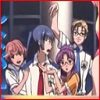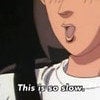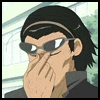| View previous topic :: View next topic |
| Author |
Message |
|
|
Beltane70
 Joined: 07 May 2007
Joined: 07 May 2007
Posts: 3986
|
 Posted: Fri Sep 14, 2018 11:41 am Posted: Fri Sep 14, 2018 11:41 am
|
 |
|
|
Ah, I remember the days of "flopped" manga! Not only do the characters look a bit off when flopped, they also become left-handed.
|
| Back to top |
|
|
|
|
Lord Geo
Joined: 18 Sep 2005
Posts: 2703
Location: North Brunswick, New Jersey
|
 Posted: Fri Sep 14, 2018 11:42 am Posted: Fri Sep 14, 2018 11:42 am
|
 |
|
|
Kodansha USA flopped the giant omnibus release of Ichi-F, and in the afterword the editor stated that it was because they wanted the manga to appeal to more than just manga fans, because of the subject matter (detailing how it is to work at/clean up the Fukushima Nuclear Power Plant after the earthquake/tsunami/meltdown).
Ichi-F, though, wasn't "flopped" the way most people think of, but rather was obviously given the Blade of the Immortal treatment, where the panels were literally re-ordered so that you read it left to right, but the artwork wouldn't be mirrored. I believe Dark Horse stated that Blade of the Immortal and Lone Wolf & Cub stayed flopped simply because they had been publishing them for so long, & they generally sold just fine in that format, so they just stuck with it.
Personally, I'm okay with flopped, but it has to make sense as to why, at the very least.
|
| Back to top |
|
|
|
CatSword
 Joined: 01 Jul 2014
Joined: 01 Jul 2014
Posts: 1489
|
 Posted: Fri Sep 14, 2018 11:46 am Posted: Fri Sep 14, 2018 11:46 am
|
 |
|
|
Chi's Sweet Home also has the potential to skew quite young, and as such has more of a potential to be picked up by parents of young children in left-to-right format. (Sure, it's fairly easy to learn how to read manga, but a lot of parents probably wouldn't want to deal with it/their child's confusion.)
|
| Back to top |
|
|
|
rizuchan
 Joined: 11 Mar 2007
Joined: 11 Mar 2007
Posts: 980
Location: Kansas
|
 Posted: Fri Sep 14, 2018 12:47 pm Posted: Fri Sep 14, 2018 12:47 pm
|
 |
|
|
Okay, so this article did a good job of explaining why manga used to be flipped and why it isn't flipped anymore, but didn't really address why any publisher would still flip manga, given how much effort it is and how small the audience that would want it is.
|
| Back to top |
|
|
|
I_Drive_DSM
 Joined: 11 Feb 2008
Joined: 11 Feb 2008
Posts: 217
|
 Posted: Fri Sep 14, 2018 1:35 pm Posted: Fri Sep 14, 2018 1:35 pm
|
 |
|
|
The only real reason I could fathom as to why an American publisher would continue to "flop" a manga would be if the target audience were really young. An example - let's assume a manga exists of it - is how Pretty Cure was changed to Glitter Force in the US. If Pretty Cure had an official manga (do any of the series have a manga?) it's likely to be marketed towards young girls whom both may not be in-tuned to anime/manga as a whole and possibly alienated by having to read a manga in it's opposite orientation. Flipping it would be a viable option for the intended market.
I still have a lot of my older manga from the "flop" period - boxes upon boxes worth. Back in the day I ordered heavily from VIZ's print mailers as they were the only way I could get manga in the largely rural area I live in. In addition to their own translated works they would also often carry titles from other publishers - CPM, Dark Horse, etc - something not really heard of nowadays. It was great because I could tick all the issues I wanted, send money, and get manga.
The only real good thing that came out of that period was the smaller number of pages printed in American comic volume style format meant more original artwork had to be used from the creator. A 200 page graphic novel currently at most has cover art and maybe an insert of some sort, whereas eight to nine volumes of "comics" would each have their own cover art. In the early and mid 1990s when internet access was still pretty scarce it was nice to be able to access original art in this manner even if was often retouched or had the series logo heavily branded at the top.
Some manga also could not be retouched despite the best of intentions simply because of the work involved. When MixxZine (TokyoPop) released Magic Knight Rayearth they flipped the pages but the main character's armor was not altered to account for this, so whereas the stage 1 armor the girls wear has a left shoulder pad it was flipped to the right and not re-touched. A very small quirk obviously but eventually confusing when I watched both the anime series and played the Sega Saturn game.
|
| Back to top |
|
|
|
LegitPancake
 Joined: 26 Jun 2017
Joined: 26 Jun 2017
Posts: 1311
Location: Texas, USA
|
 Posted: Fri Sep 14, 2018 2:12 pm Posted: Fri Sep 14, 2018 2:12 pm
|
 |
|
|
It’s really a shame that Akira is still being sold in stores in left-to-right format, and the only way to read it legally R->L is buying the really expensive Amazon/Rightstuff exclusive box set, and there’s no digital alternative. I just can never afford to buy the whole thing all at once. It’s also weird that Dark Horse decided to keep the flipped version of Blade of the Immortal when they republished it in omnibus format. I for one am unwilling to buy that.
|
| Back to top |
|
|
|
|
Aleximonious
Joined: 10 Feb 2017
Posts: 7
|
 Posted: Fri Sep 14, 2018 3:35 pm Posted: Fri Sep 14, 2018 3:35 pm
|
 |
|
| I_Drive_DSM wrote: | | The only real reason I could fathom as to why an American publisher would continue to "flop" a manga would be if the target audience were really young. |
The other reason I can think of is the old, flopped print files are the one that the publisher still has on file, and that the process of creating new files (retrieveing the original, touch up, typesetting and editing) will cost more than the next print run will make back.
|
| Back to top |
|
|
|
NeoStrayCat
 Joined: 14 Sep 2011
Joined: 14 Sep 2011
Posts: 635
|
 Posted: Fri Sep 14, 2018 4:31 pm Posted: Fri Sep 14, 2018 4:31 pm
|
 |
|
| I_Drive_DSM wrote: | | The only real reason I could fathom as to why an American publisher would continue to "flop" a manga would be if the target audience were really young. An example - let's assume a manga exists of it - is how Pretty Cure was changed to Glitter Force in the US. If Pretty Cure had an official manga (do any of the series have a manga?) it's likely to be marketed towards young girls whom both may not be in-tuned to anime/manga as a whole and possibly alienated by having to read a manga in it's opposite orientation. Flipping it would be a viable option for the intended market. |
Well, at least I can tell you straight that Pretty Cure manga actually exists, cause I went to the Kinokuniya in LT and they do have them, untranslated, of course. However, I'm gonna have to disagree on the flipping thing, while it would make sense to market it that way, to me, its not really viable and a good idea myself.
|
| Back to top |
|
|
|
zawa113
 Joined: 19 Jan 2008
Joined: 19 Jan 2008
Posts: 7359
|
 Posted: Fri Sep 14, 2018 6:30 pm Posted: Fri Sep 14, 2018 6:30 pm
|
 |
|
|
Ah, the old days! Glad they stopped that practice! I think they stopped it around the time I was getting into manga, so I was still buying some series (like Ranma 1/2 or Carcaptor Sakura) flipped, but most of what I got was unflipped. I know Viz switched book sizes partway through Ranma 1/2, but until these more recent 2-in-1s, they published the entire series flipped.
I do still have a good number of really great manga that were never published unflipped though. Most all of them have been out of print for ages on top of it. What's Michael?, 2001 Nights, Four Shojo Stories, Eagle, Sanctuary, a bunch of Tezuka, Kazan, Rumic World/Rumic Theater, and Silent Mobius (maybe some other things I'm forgetting)
Some other weird things I'm remembering about flipped manga was that time Viz made three different versions of vol 1 of Firefighter Daigo, which became one of their worst selling series of all time (which is a shame, it's a damn good series). They made two oversized versions, one flipped, one unflipped (which was further labeled as "special edition"), and then they made a 2nd edition in the modern size that we all know and love (and fits the rest of the series).
Nowadays, I think the only things that are published flipped are re-prints of older things (Dark Horse and Blade of the Immortal and Lone Wolf & Cub), things that are meant to appeal to really little kids (Chi's Sweet Home), and stuff from UK published Fanfare (a lot of Jiro Taniguchi stuff)
I do also quite vividly recall that the "100% Authentic Manga" thing. I think, while it was great for manga and making it acceptable for unflipped to reign, for me, it turned me completely off to Korean manhwa. I guess I viewed it as "fake manga", and then Tokyopop's huge OEL push didn't help that either. To be fair, both their OEL and manhwa has some true gems but were mostly a lot of average to bad series and they also both felt like "fake manga" to me and I overlooked some really great series for years by mistake. I kind of wish manhwa in print could make a comeback (so many people read Korean webtoons and I know that a lot of them get physical print versions in Korea as well)
|
| Back to top |
|
|
|
|
SaiyamanMS
Joined: 05 Oct 2006
Posts: 302
|
 Posted: Fri Sep 14, 2018 11:09 pm Posted: Fri Sep 14, 2018 11:09 pm
|
 |
|
| Quote: | | There's a full-color edition of Dragon Ball published by Viz Media too. |
I’m a little puzzled how this release is relevant to flopped manga seeing as not only is it unflopped, but it’s an English edition of a Japanese release. In fact, it’s the only English edition of Dragon Ball to keep the original Japanese sound effects.
|
| Back to top |
|
|
|
|
RegSuzaku
Joined: 08 Jul 2018
Posts: 273
Location: Ikebukuro
|
 Posted: Sat Sep 15, 2018 8:02 am Posted: Sat Sep 15, 2018 8:02 am
|
 |
|
|
And then you have artists (like me) who are trying to write a (web) comic to do in both Japanese and English, and wondering what direction to draw it in. I don't want to be boxed in with American superheroes, but I don't want to look like a weeb for drawing it the other way...
|
| Back to top |
|
|
|
Shar Aznabull
 Joined: 12 Jan 2015
Joined: 12 Jan 2015
Posts: 236
|
 Posted: Sat Sep 15, 2018 8:53 am Posted: Sat Sep 15, 2018 8:53 am
|
 |
|
|
For the most part I much prefer unflopped, but in the case of Studio Proteus's translation output there was clearly a lot of effort put into making sure it preserved the original artwork and readability so I don't really mind some of Dark Horse's still flopped manga.
|
| Back to top |
|
|
|
mike.motaku
 Joined: 22 Feb 2006
Joined: 22 Feb 2006
Posts: 160
Location: Indiana
|
 Posted: Sat Sep 15, 2018 9:49 am Posted: Sat Sep 15, 2018 9:49 am
|
 |
|
|
One area that drives me nuts is when a manga is carried by a library they still process it as if it were a typical North American-style book. So what would be the back cover of any other book but is the front cover in manga, gets all the stickers and labels that go with any book being in a library collection. It seriously messes up the cover illustration and obscures the title.
|
| Back to top |
|
|
|
|
jdnation
Joined: 15 May 2007
Posts: 2137
|
 Posted: Sat Sep 15, 2018 10:50 am Posted: Sat Sep 15, 2018 10:50 am
|
 |
|
| rizuchan wrote: | | Okay, so this article did a good job of explaining why manga used to be flipped and why it isn't flipped anymore, but didn't really address why any publisher would still flip manga, given how much effort it is and how small the audience that would want it is. |
I think it's just self evident.
Older manga that was already flopped already took the time and trouble to alter it.
So they continue to sell it that way, precisely because the printing press is already used to it and because they hope to attract non-manga readers.
I don't think any new releases are flopping anymore, it's likely just old ones.
I have a few flopped versions. For example all of Akira, and some volumes of the Eva manga. But now I prefer unflopped precisely because I want the preservation of the original artwork.
|
| Back to top |
|
|
|
leafy sea dragon
 Joined: 27 Oct 2009
Joined: 27 Oct 2009
Posts: 7163
Location: Another Kingdom
|
 Posted: Sat Sep 15, 2018 11:23 am Posted: Sat Sep 15, 2018 11:23 am
|
 |
|
| Beltane70 wrote: | | Ah, I remember the days of "flopped" manga! Not only do the characters look a bit off when flopped, they also become left-handed. |
And text becomes inverted too, which becomes jarring when it's in English. Viz frequently used the example (and they still do occasionally) of "MAY," which becomes "YAM."
| Lord Geo wrote: | | Ichi-F, though, wasn't "flopped" the way most people think of, but rather was obviously given the Blade of the Immortal treatment, where the panels were literally re-ordered so that you read it left to right, but the artwork wouldn't be mirrored. |
Wow, that sounds INCREDIBLY difficult, and perhaps sometimes impossible, as you'd have to redo a lot of the artwork. Manga paneling has key differences from American comics paneling, such as characters standing in front of panels and the use of long, thin panels of continued landscape (or blank white, in the case of stuff like Food Wars! Shokugeki no Soma) to indicate time has passed. The former is rare in American comics; the latter is found only in manga-inspired works.
| CatSword wrote: | | Chi's Sweet Home also has the potential to skew quite young, and as such has more of a potential to be picked up by parents of young children in left-to-right format. (Sure, it's fairly easy to learn how to read manga, but a lot of parents probably wouldn't want to deal with it/their child's confusion.) |
There's also a strong chance the parents would flip through it first, and it would help if the non-savvy parents could understand what was happening. From what I heard, multitudes of people continued to attempt to read Viz's Weekly Shonen Jump the wrong way, despite the disclaimer at the left end of the book in each issue (there are no official sources I found on it though).
| #884745 wrote: | | And then you have artists (like me) who are trying to write a (web) comic to do in both Japanese and English, and wondering what direction to draw it in. I don't want to be boxed in with American superheroes, but I don't want to look like a weeb for drawing it the other way... |
It depends on your audience. If you're aiming for people who usually read a lot of manga, go right-to-left, but otherwise, do left-to-right. If you choose right-to-left, be sure to explain it at the beginning, because comics created natively in English do not naturally read from right-to-left, and people who read comics other than manga will be confused.
I have encountered many comics found online that I had problems reading until I learned they were supposed to be right-to-left. If it's in English to begin with, I default to left-to-right. Absolutely none of them had the heads-up, so I was confused until I either found some panel layout that suggested right-to-left, I found speech bubbles located in the 2 o'clock and 8 o'clock positions, or I just tried it the other way and it made more sense.
My own comics were always left-to-right, but I stuck strictly to comedy. (As a matter of fact, they were inspired not by the superhero comics of DC and Marvel, but by comic strips found in the newspapers.) No one had a problem with understanding how it was read. No one associated them with superhero stories (though I didn't mind, and I read American comics too).
| rizuchan wrote: | | Okay, so this article did a good job of explaining why manga used to be flipped and why it isn't flipped anymore, but didn't really address why any publisher would still flip manga, given how much effort it is and how small the audience that would want it is. |
It's to appeal to audiences outside of the existing manga readers, who by and large are not really aware of the right-to-left order and might miss the disclaimers. I've met plenty who attempted to read manga, but it didn't make any sense, so they put it down and chalked it as one of those things those kids do (the standout example being my robotics teacher in high school, though he noticed the disclaimer afterward but couldn't get used to it).
The manga reaches a wider audience done left-to-right than right-to-left. The devoted fans will disagree vehemently (and this being a large website about Japanese culture, the devoted fans will be the majority here), but I have never encountered a fandom in which the devoted fans are in agreement with the general public anyway.
This is the "large casual audience" versus "small hardcore audience" that makers of pretty much everything must make. Rarely does anything manage to get both.
|
| Back to top |
|
|
|
|
